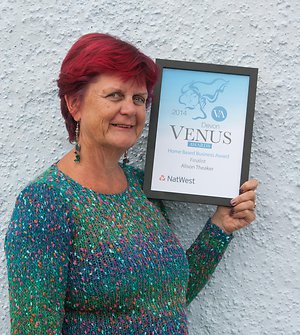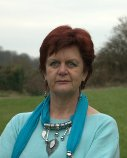Walkspiration
To complement my new Walk the Talk style of coaching, I have set up a blog where I will talk about what inspiration I have found during my weekly walks. The blog is Walkspiration
The Spark is a Venus Awards Finalist
I was delighted to make the finalists shortlist for the 2014 Devon Venus Awards. Referred to as the Working Women’s Oscars, the Venus Awards were formed in 2009 to recognise, reward and celebrate local working women in business. The Venus Awards began in Dorset and has since expanded into other regions across the country.
I was also a semi-finalist in the Business Mother category, which involved going to Exeter to make a video, which was then posted for a public vote. Then we all went to a fabulous event at the Deer Park Hotel near Honiton where the finalists were announced.
At both the events the energy and excitement of a crowd of women entrepreneurs was exhilarating and inspiring.
When I found out about the Awards, having met founder Tara Howard, I spread the word to all the women's networks I attended. I was surprised to find the reception often lukewarm at best. Women seemed to feel uncomfortable with the idea of either putting themselves forward, or asking one of the clients to nominate them. Was that what Sheryl Sandberg was talking about in her controversial book, Lean In? It's not about being bigheaded or arrogant, it's about it being OK to celebrate something that we have done well.
I'm looking forward to the Awards Dinner in November, and spending time with women who are changing the business world by running their own businesses they way they want them. And I would encourage others out there who are doing a good job to step forward to get some recognition! Here's more information about the Venus Awards
Top Tips for 2013
Speaking at the Women's Development Unlimited Awards dinner, I was asked to give my top tips for 2013. Here they are:
Salami and red wine
If you have a task that you keep putting off because it is just too big, salami slice it into manageable chunks. Then give yourself a reward (in this case the glass of red wine)when you complete each slice. However, don't make the salami slices too thin and the glasses of red wine too big!
There is no such thing as failure
Edison said, "I haven't failed to invent the electric light bulb, I've discovered yet another way NOT to invent the electric light bulb." He kept going, through 5,000 attempts. So when things are not going the way you want them to in your business, you've just discovered another way NOT to invent the electric light bulb. Everything you do gives you information about what works and what doesn't.
Keep the faith
If you wanted to run a marathon, you wouldn't expect to just get out on the road immediately and run 26 miles. You train, change your diet, buy some better running shoes. Running your business is like that. Sometimes you have bad days, your cash flow slows to a trickle, you wonder if it is all worth it and you start to doubt your own passion. Just remember, you start running the marathon the day you sign up and start your training.
How Action Learning can help your business
Businesses need to deal with the changing environment and to cope with change at the current pace it is vital that people are able to think for themselves. If your business involves people and you want to get the best from them, action learning could save you time and money as well as making your staff more effective and enthusiastic.
The benefits of action learning lie in the level of engagement of people with the solution of issues in the workplace. Working in public relations and management in the UK and US over the past 25 years, I have seen too many changes simply pasted onto existing situations. Having witnessed the transformational nature of action learning both as a facilitator and set member, I know it is an effective way of achieving a shift in seemingly insurmountable problems.
Fast
Action learning is also remarkably fast. The set moves quickly from the issue to what the person is trying to achieve. For time-pressed organisations that are having to deal with a constant stream of new products, services and customers, this can simultaneously solve problems whilst developing staff and building teams.
Action learning “sets” consist of between 5- 8 people who agree to meet on a regular basis, perhaps once a week for 6 weeks, with a trained facilitator. Everyone has the chance to present their problem in turn. Issues could be a shared objective or challenge, such as how to manage cuts and redundancies, or individual problems such as “I just can’t work with Bob”.
Effective
Why is it so effective? Individuals are given the time to talk uninterrupted, which allows them to discover what it is they already know and to think of solutions that will work. Those listening learn to appreciate others’ ideas and devise insightful questions rather than simply offering advice. The presenter gets to the heart of the issue, coming up with actions that they commit to before the next meeting. The facilitator holds the group together and ensures that everyone is heard. The set becomes a support network and members find that they become more confident in dealing with others, which leads to more productive working relationships across the organisation.
Sole traders can also benefit by forming a set of Chamber contacts or through other networks. Women do Business is currently supporting women throughout Devon to take their businesses to the next level by using action learning sets.
Action learning was pioneered by Reg Revans in the 1940s, who worked with the Coal Board and increased productivity by consulting the miners on the coal face about how to move the organisation forward. His principle was that the key to improving performance lay not with ‘experts’ but with practitioners. Companies who use it include Boeing, Samsung, LG and Deutsche Bank. Oxford University Press used it to sharpen up service provision and reduce costs.
Time out
Taking time out from a busy work schedule to participate in a set is a challenge. However, creating space to work through problems in a supportive environment can lead to real organisational change, save time in the long run and empower individuals in the workplace.
Further reading:
Kine, N (1999) Time to Think, Cassell.
Pedlar, M, (2008), Action learning for managers, Gower.
Getting the word out
Despite the plethora of communication channels available, books are still in demand. Not everyone can manage a Kindle, and reading on screen is 25% more difficult than reading hard copy.
If you decide that you would like to see your name in print, there are two ways to go – either persuade a publisher that you have a good idea, or self publish. Both routes have their advantages and drawbacks.
Publishing
Look at the kinds of books that are already out there in the marketplace and research the possible competition. What do you have to say about the subject that is different to the others? Who publishes the kinds of book you think you want to write?
Next, look in the Writers and Artists Yearbook for the contact details of the publishers you’ve pinpointed. That normally gives advice on what subjects they are looking for. See who the commissioning editor is in your subject. Can you think of a three sentence synopsis of your book? Call up the commissioning editor and have an initial chat – a good way to start building a relationship.
Each publisher will have a standard proposal form to fill in. You’ll be asked for title, draft contents, an estimation of the market and how your book will stack up against the competition. Some also ask for a sample chapter if you have not published before. They will also ask for your CV and a justification of why you are the right person to write this book. Don’t be shy here!
Your proposal is normally first discussed at an editorial team meeting, which are often held only once a month. At that stage, the team decide which ones to go forward with. You may be asked to amend or expand it, and then they will send it out to peer reviewers – experts in the field – who will be asked to comment on whether your proposal is reasonable or not.
If you have managed to jump through all the hoops, then, as Agatha Christie said, “you just have to find time to write the thing!” Make sure you have a realistic timescale set out in your contract.
You may also find that you get a small advance – mine was £1,000 for my first text book. That doesn’t sound bad until you factor in that it took me 18 months to write it! Then the advance comes off your royalties until the publisher has made that amount back – and your royalties are likely only to be 6% or less of the price that the publishers receive for your book – not even the cover price. Some bookshops expects at least 40% off the cover price to sell a book, and discounts may be higher for some suppliers.
However, once you have finally got the copy in, corrected the proofs and put together the index, you can sit back and let the publisher print and market your book. You will also get a few free copies that you can put on your bookshelf or show to prospective clients. You can also use the book on all your marketing materials and link to the publisher’s website and amazon to encourage people to buy it. If your book is successful, the publisher may come back to you for further updates and editions, all with new contracts, advances and royalties. This is the state to aim for – it is never as strenuous to write further editions as the first one. My own textbooks have gone to 3 editions each, and I am in the process of putting together a fourth edition of the most popular one. They have also been translated into other languages, and each time that happens you get another one-off payment. The most fun I had was turning up for the launch of the textbook in Croatia to find 100 people had paid to hear me speak and take away a signed copy – the champagne reception might have had something to do with it though!
The timescale is more lengthy than you might imagine. The edition I have in preparation now was agreed in March and the deadline for copy is February. The book will not appear on the shelves until next September. Once it is out there, I should make my advance back in about six months, and after that the royalty cheques will come in once a year. So after your advance, you may be looking at two years before any more money starts rolling in.
Self-publishing
Self publishing falls into two further sub-divisions. You can manage the entire process yourself – writing, finding a printer and cover designer and marketing. In this case you will have to pay up front for a number of copies and also store them whilst you are hawking them around the countryside in the boot of your car trying to persuade bookshops to stock them. Having said that, one of the successes of the self help genre, the Celestine Prophecy, was self published in this way and happened to catch the eye of a publisher’s rep who visited the shop where it was being sold. It was then taken up by a mainstream publisher and sold worldwide. On a smaller scale, I once met the author of a self-published novel set in Cornwall. This enterprising man had persuaded all the service stations up and down the A30 to stock his book and he also went round the country selling at fairs. The cover price was £10, but it only cost him £1 per copy to produce. When I met him some years ago he had already sold 25,000 copies. That’s a hefty £225,000 profit.
Many people go the route of on-demand publishing. Here you send your text to a company who undertakes to place your book on amazon. Then every time someone orders one, they print it off. You can normally buy a variety of packages. When I self-published my novel I paid for a critique of the text and also got a friend to design the cover rather than use one of the templates available. I was responsible for proofing and was able to have 50 further amendments on the final proof. Even though I had read the copy several times and had others proof it too it was amazing how many errors had slipped through. One character even had a different name at different stages in the book!
I was also responsible for marketing it and directing people to the website. Despite using all my PR and marketing skills, no one was willing to review a self-published book as it is regarded as “vanity” publishing. I managed to sell around 450 copies by emailing all my friends and relations, doing readings at various events and selling at school fetes. However, by the time I had sold 100 copies I had covered my cost, and the deal I had gave me good royalties on the ones that were sold through the publisher’s website. I could also buy them at a 40% discount and make that back if I sold them at cover price. The latter wasn’t always practical – print on demand books are quite expensive to produce and often carry a high cover price because they do not benefit from large scale print runs. My book was supposed to sell at £14 which does not stack up against the likes of Tesco and other supermarkets where you can buy cheaper paperbacks by well known authors. I found that I could sell to people I knew, whether present or not, but that if I wanted to sell to people I didn’t know, then I had to actually be there to do a reading or talk about the book.
However, non-fiction books tend to be easier to sell because they can be marketed to a niche audience. You have to be prepared to put the work in though.
It is immensely satisfying to hold the first copy of your book in your hand and see your name emblazoned on the cover. Realistically though, few authors make their living through their writing – only 1% of the US Society of Authors lives off their book sales – so your royalties are more likely to take you to Bognor than Barbados. However, you can sell it to your clients and via your website, and have it available for signing at workshops. The best feeling is seeing just how much you do know when you see your own words in print.
There are also several free packages available now to publish your book electronically, including through amazon and smashwords. It is worth investigating to add Kindle or e-book formats to your print version to make sure you are making it easy for people to buy your book!


